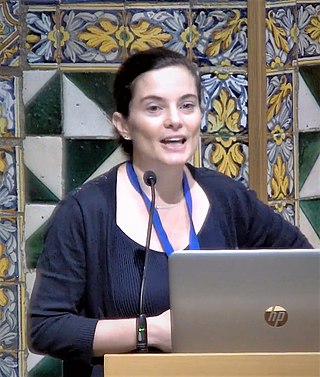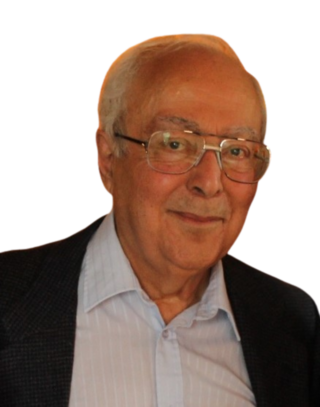Naomi J. Halas is the Stanley C. Moore Professor in Electrical and Computer Engineering, and professor of biomedical engineering, chemistry, and physics at Rice University. She is also the founding director of Rice University Laboratory for Nanophotonics, and the Smalley-Curl Institute. She invented the first nanoparticle with tunable plasmonic resonances, which are controlled by their shape and structure, and has won numerous awards for her pioneering work in the field of nanophotonics and plasmonics. She was also part of a team that developed the first dark pulse soliton in 1987 while working for IBM.

Zinc pyrophosphate (Zn2P2O7) is an ionic inorganic chemical compound composed of Zn2+ cations and pyrophosphate anions.

Xylitol pentanitrate (XPN) is a nitrated ester primary explosive first synthesized in 1891 by Gabriel Bertrand. Law enforcement has taken an interest in XPN along with erythritol tetranitrate (ETN) and pentaerythritol tetranitrate (PETN) due to their ease of synthesis, which makes them accessible to amateur chemists and terrorists.

Potassium bifluoride is the inorganic compound with the formula K[HF2]. This colourless salt consists of the potassium cation and the bifluoride anion. The salt is used as an etchant for glass. Sodium bifluoride is related and is also of commercial use as an etchant as well as in cleaning products.

Vanadium(V) fluoride is the inorganic compound with the chemical formula VF5. It is a colorless volatile liquid that freezes near room temperature. It is a highly reactive compound, as indicated by its ability to fluorinate organic substances.

Anthony Gerard Martin Barrett is a British chemist, and Sir Derek Barton Professor of Synthesis, Glaxo Professor of Organic Chemistry at Imperial College London. He is Director of the Wolfson Centre for Organic Chemistry in Medical Science. He was elected a fellow of the Royal Society in 1999 and Academy of Medical Sciences in 2003. He obtained a BSc as well as PhD from Imperial College London in 1973 and 1975 respectively.

Helen Irene Battle was a pioneering Canadian ichthyologist and marine biologist. She was the first Canadian woman to earn a PhD in marine biology and she was also one of the first zoologists to engage in laboratory research. She was an emeritus professor of zoology at the University of Western Ontario from 1972.
The fluorosulfates or fluorosulfonates are a set of salts of fluorosulfuric acid with an ion formula SO3F−. The fluorosulfate anion can be treated as though it were a hydrogen sulfate anion with hydroxyl substituted by fluorine. The fluorosulfate ion has a low propensity to form complexes with metal cations. Since fluorine is similar in size to oxygen, the fluorosulfate ion is roughly tetrahedral and forms salts similar to those of the perchlorate ion. It is isoelectronic with sulfate, SO4−2. When an organic group is substituted for the anions, organic fluorosulfonates are formed.
Jeff Dahn is a Professor in the Department of Physics & Atmospheric Science and the Department of Chemistry at Dalhousie University. He is recognized as one of the pioneering developers of the lithium-ion battery, which is now used worldwide in laptop computers, cell-phones, cars and many other mobile devices. Although Dr. Dahn made numerous contribution to the development of lithium-ion batteries, his most important discovery was intercalation of Li+ ions into graphite from solvents comprising ethylene carbonate, which was the final piece of the puzzle in the invention of commercial Li-ion battery. Nevertheless, Dahn was not selected for the 2019 Nobel Prize in Chemistry, which recognized only John Goodenough, M. Stanley Whittingham and Akira Yoshino.
Russell Jaye Boyd is a Canadian computational and theoretical chemist. He is Professor Emeritus at Dalhousie University in Halifax, Nova Scotia.
Cathleen M. Crudden is a Canadian chemist. She is a Canada Research Chair in Metal Organic Chemistry at Queen's University at Kingston. In February 2021, she took up the role of Editor-in-chief at ACS Catalysis.
Erin Johnson is a Canadian computational chemist. She holds the Herzberg–Becke Chair at Dalhousie University. She works on density functional theory and intermolecular interactions.
Linda Faye Nazar is a Senior Canada Research Chair in Solid State Materials and Distinguished Research Professor of Chemistry at the University of Waterloo. She develops materials for electrochemical energy storage and conversion. Nazar demonstrated that interwoven composites could be used to improve the energy density of lithium–sulphur batteries. She was awarded the 2019 Chemical Institute of Canada Medal.
Ida Pavlichenko is an Azerbaijani biomedical engineer and a Technology Development Fellow at the Harvard University Wyss Institute for Biologically Inspired Engineering. Pavlichenko is the co-founder and chief executive officer of PionEar Technologies, a medical device company that develops intelligent technologies for treating ear and hearing disorders. The tympanostomy technology she invented for treated recurrent ear infections has been nationally recognized for its innovative design which addresses many of the limitations of current ear tubes.

Clémence Corminboeuf is a Swiss chemist who is Professor of Computational chemistry at the École Polytechnique Fédérale de Lausanne. She was awarded the Swiss Chemical Society 2021 Heilbronner-Hückel Award.
Linda Jean Broadbelt is an American chemical engineer who is the Sarah Rebecca Roland Professor and associate dean for research of the McCormick School of Engineering and Applied Science at Northwestern University. Her research considers kinetics modeling, polymerization and catalysis.
Jennifer Ann Love is an American professor of chemistry at the University of Calgary. She is a Fellow of the Chemical Institute of Canada.
Mita Dasog is an associate professor at Dalhousie University in Nova Scotia, Canada. She has received the Emerging Professional Award, the Canadian Council of University Chemistry Chairs Doctoral Award, is a “Top 25” Global Young Scientist in Sustainable Research, and is one of the top 150 women in STEM for her outreach efforts with youth and young women.

Lorne Elias is a Canadian chemist, inventor, and a pioneer in explosives detection technology. He invented the explosives vapour detector, EVD-1, a portable bomb detection instrument deployed at international airports in Canada in the 1980s. He contributed to the field of explosives detection for over three decades, and is called the father of vapour and trace explosives detection technology.
Hanadi Farouk Sleiman is a Canadian chemist who is Canada Research Chair in DNA Nanoscience at McGill University. Her research makes use of DNA as a template for nanomaterials. She was awarded the Natural Sciences and Engineering Research Council Polanyi Award in 2021.








